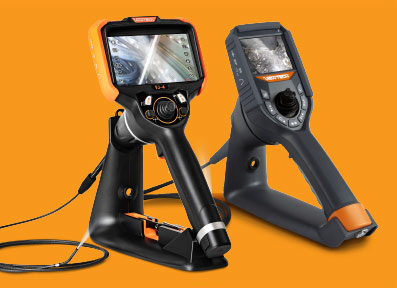ViewTech VJ-Series Borescopes Are the Industry Leaders
See if a VJ-Series is the right borescope for you.

ViewTech Borescopes FAQ’s
Look through our frequently asked questions or please contact us if you don’t see your particular question.
The best way to ensure a VJ-Series borescope is the right choice for your particular inspection applications is to take advantage of our Free Borescope Demo Program. If you would like additional warranty and product materials, please visit our customer resources page.
Yes, ViewTech’s video borescopes use 3.6V lithium ion rechargeable batteries. Included with each borescope is a battery charger with AC adapter. The VJ-3 borescope comes with 2 batteries (1 additional) and the VJ-4 borescope will have 4 batteries (2 additional).
The VJ-3 and VJ-4 borescopes use 18650B with PCB-protection, 3.6V lithium ion batteries. Typical life is 3-4 hours between charge cycles. Most 18650B batteries have a life cycle of 250-500 charges. If any damage is noticed on the battery, it should be discarded immediately.
The operating temperature for the base unit is -20°-50°C (-5°-120°F)
The operating temperature for the insertion tube is -10°-50°C (15°-120°F)
It is best to choose the shortest length that will suit your inspection needs for a number of reasons. First, the shorter the insertion tube, the greater the degree of articulation in the bending section. Second, shorter insertion tubes are easier to handle and work with than longer insertion tubes. Finally, shorter insertion tubes are less expensive to buy and repair.
While a video borescope with an insertion tube length greater than 8 Meters is normally not an off-the-shelf and in-stock item like all borescopes for sale detailed throughout our website, ViewTech Borescopes does custom insertion tube length orders! Contact us to discuss your application today.
Note: In our discussions with many borescope technicians we have found that technicians can often access their inspection targets from multiple locations. Using this principle, for example, a technician may be able to inspection a 50 foot pipe with an 8 meter (26’3″) borescope if the inspector can start the inspection from each end of the pipe.
The camera, bending section and insertion tube are liquid-proof. The handheld portion of the borescope is not liquid-proof. During an inspection, the insertion tube will often come into contact with oil, lubricants, diesel, kerosene, jet fuel, etc. This is not a problem. After such use, the insertion tube should be wiped off with a dry rag and allowed to air dry. Care should be taken when drying the bending section, and it should be “dabbed” dry instead of “rubbed” dry. Watch this video on how to properly clean your ViewTech video borescopes.
The only common liquid that should be avoided, if possible, is gasoline, because gasoline is more corrosive than other fuels or lubricants. Incidental contact with gasoline will not damage the scope, but prolonged contact or soaking in gasoline may damage the scope.
Yes, all ViewTech borescopes are equipped with a zoom feature.
Yes, the VJ-4 borescope offers reference measurement. Read more about VJ-4 Video Borescope Reference Measurement or contact us to trial the VJ-4 borescope at your facility.
There are a number of key differences between these low-end products and the VJ-3 and VJ-4 video borescopes.
Articulation: Low-end videoscopes do not articulate (meaning the camera section cannot be controlled and pointed in other directions). A scope without articulation is like a car without a steering wheel. It’s great as long as you only need to go straight. These low cost scopes may work well for certain types of inspections, such as small-bore pipe inspections, where there would be no room to move an articulating tip. In the vast majority of cases, the usefulness comes from being able to place the insertion tube into an inspection area and then move the camera around to see what you need to see. The ability to articulate the camera is the most critical feature missing from low-end scopes, and the value of articulation cannot be overstated.
Image or Video Capture: If a technician ever wants to archive pictures of an inspection, get a second opinion, compare the same part from one date to the next, or show a customer the results of an inspection, you must have image and video capture. Most low-end scopes do not have an image or video capture. Some of these products may have a video output through which you could record an inspection on a computer, but this adds complexity and cost while reducing portability.
Image Quality: ViewTech uses high end camera and lens systems to deliver pixel resolutions up to 2,073,600 pixels and a focal range of 7mm to infinity. Check the resolution and focal range of these systems and you will see that they are usually inferior to a ViewTech video borescope.
Insertion Tube Material: VJ-3 and VJ-4 borescope insertion tubes are pliable enough to snake through bends, elbows and curves. Some of the low-end product insertion tubes are too rigid to do this. Some are made out of metal goose neck material, much like electric wire conduit. This type of insertion tube material, combined with a lack of articulation, significantly reduces the type of inspection scenarios in which it can be used.
Repair of a VJ-3 or VJ-4 borescope is to be performed only by ViewTech Borescopes. Do not disassemble or attempt to repair the borescope, as this will immediately void the warranty. Contact us to discuss the issue you are experiencing and start the simple repair process.
Yes, the VJ-3 and VJ-4 borescopes can be rented for a day, a week or months. Contact us to discuss the length of time you are requiring a rental borescope.
ViewTech video borescopes are MIL-STD 810G certified. Read more information about using a ViewTech borescope in an explosive environment.
Demo Heading
Success Story

Over 15 Years of Experience
The ViewTech Borescopes team was established in 2008 with the goal of bringing affordable, high-quality video borescopes to the market.
Request a Free Demo Unit
Check the box in the form below and one of our representatives will arrange a free demo unit.
Call Us at 231-943-1171
– Or –
Fill out the form below and one of our representatives will contact you.







